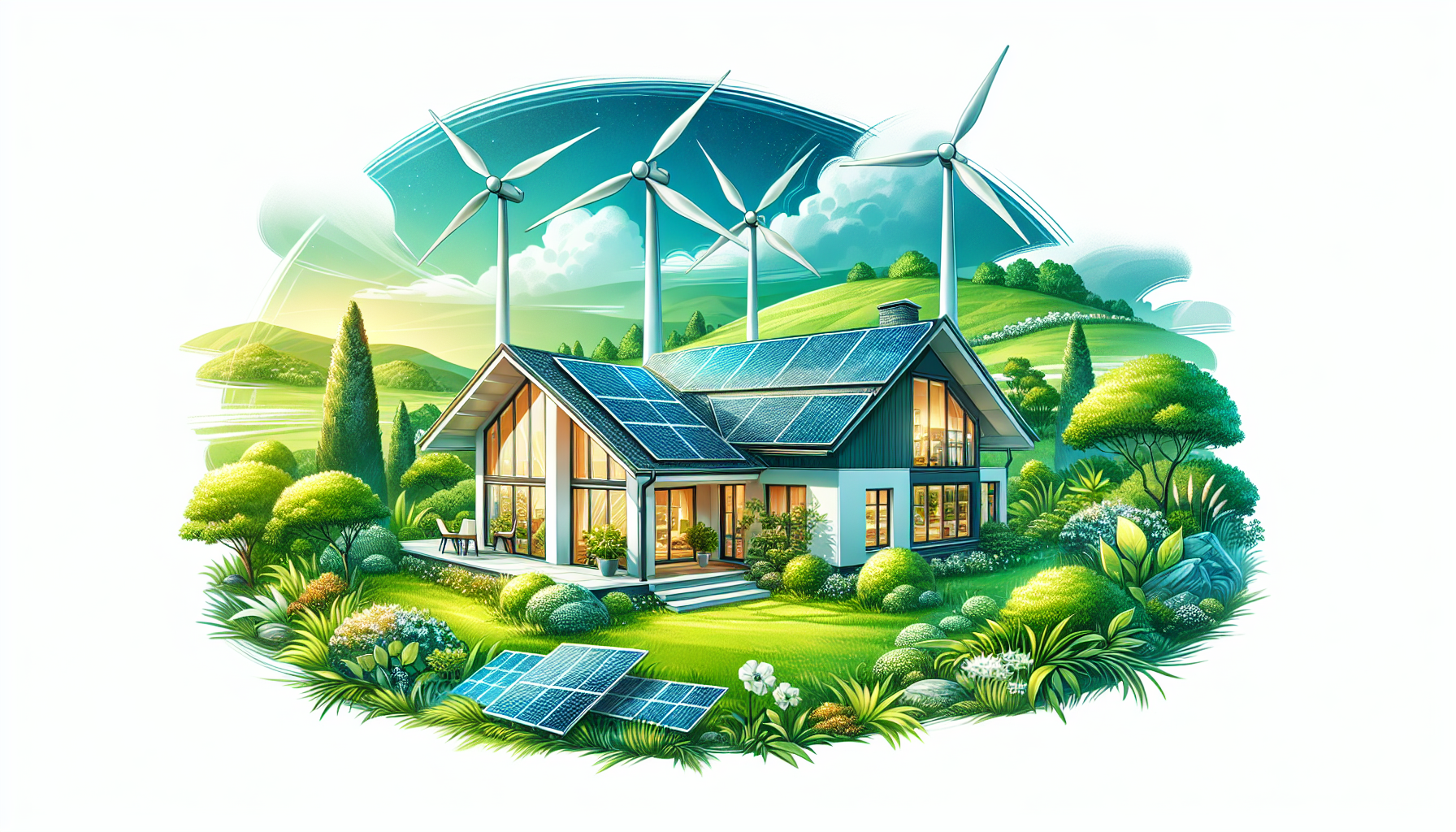Empowering Change: The Role of Sustainable Living in Combating Climate Change
At a time when climate change is reshaping the globe, what can your everyday life contribute to the solution? This informative guide delves into the role of sustainable living in combating climate change by showcasing how personal habits and choices—ranging from energy consumption to dietary patterns—lead to significant environmental benefits. Embark on this journey to discover how sustainability intersects with individual action to forge a powerful weapon against the global climate challenge.
Key Takeaways
-
Adoption of renewable energy systems like solar panels, wind turbines, and geothermal heating and cooling can significantly reduce fossil fuel dependence and household carbon footprints, supporting climate change mitigation efforts.
-
Sustainable transportation choices—such as using electric vehicles, bicycles, and public transit—play a critical role in reducing greenhouse gas emissions, contributing to the development of sustainable cities.
-
Embracing plant-based diets, mindful shopping, waste reduction, and engaging in policy advocacy are key to driving environmental protection and resilience, reflecting the interconnected nature of personal choices and global sustainability efforts.
Harnessing Renewable Energy at Home

Reducing dependence on fossil fuels and slashing greenhouse gas emissions is achievable by harnessing renewable energy within our homes. The adoption of solar panels, wind turbines, and geothermal systems allows us to conserve natural resources, and more importantly, take a proactive stance in climate change mitigation.
Understanding how these sustainable living practices can transform our homes into energy efficiency powerhouses is crucial.
The Sun's Power: Solar Energy Solutions
Solar panels are not mere accessories to our rooftops; they are powerful allies in the battle against rising energy consumption. Homeowners who tap into the sun’s abundant energy enjoy lower electricity bills, reduced grid dependence, and a contribution to a cleaner environment.
Solar energy systems, including rooftop solar panels and water heating solutions, are practical and effective across various climates, providing a renewable resource that promises an endless supply of clean power.
Embracing the Wind: Residential Wind Turbines
Wind turbines are no longer just fixtures of rural skylines; they have a place in residential areas, too. Residential wind turbines offer homeowners the ability to generate their own power, significantly decreasing their carbon footprint.
Considering that wind energy is markedly less carbon-intensive than traditional fossil fuels, investing in a wind turbine for your home contributes to a cleaner, more sustainable future.
Earth’s Warmth: Geothermal Heating and Cooling
The ground beneath our feet holds a reservoir of energy ripe for the taking. Geothermal heating and cooling systems harness this stable underground warmth, offering a sustainable and cost-effective solution for regulating our home climate. The energy savings are substantial, with systems requiring minimal maintenance and providing consistent comfort regardless of the changing climate above.
Reducing Carbon Footprint Through Transportation Choices

Our daily commutes and travel habits have a significant environmental impact, but green transportation options can steer us toward a more sustainable course. Choosing electric vehicles, bicycles, or public transit not only combats climate change but also contributes to the creation of sustainable cities. Each of these choices plays a vital role in lessening our environmental footprint.
Shift to Electric: The Rise of EVs
The road to sustainability is paved with electric vehicles (EVs). These marvels of innovation offer a breath of fresh air, literally, with zero tailpipe emissions. When charged with renewable energy, EVs make a substantial dent in CO2 emissions from the transportation sector, contributing to cleaner air quality and supporting the infrastructure for a greener future.
Pedal Power: Biking as a Sustainable Alternative
Cycling isn’t just a way to stay fit; it’s a pathway to reducing our reliance on fossil fuels. Bike riding stands as a zero-emission mode of transportation that diminishes the environmental impact of vehicle production and road wear.
Its integration into urban development, through the inclusion of bike paths, makes sustainable living more accessible and practical.
Public Transit: Connecting Communities Sustainably
Public transit is the unsung hero of urban sustainability, efficiently reducing carbon dioxide emissions and bridging communities. In the United States alone, public transportation saves millions of metric tons of carbon dioxide annually. By choosing transit over driving, we contribute to a significant drop in the need for environmentally harmful chemicals associated with car use, fostering a healthier planet.
Adopting a Plant-Based Diet to Lower Emissions

The food on our plates holds power over our planet’s health. Adopting a plant-based diet can significantly lessen the environmental impact of meat production and conserve invaluable resources such as water. This shift in dietary habits is a vital climate change measure, supporting sustainable agriculture and fostering a healthier ecosystem.
Beyond Meat: The Environmental Impact of Livestock
The environmental toll of livestock farming is heavier than many realize, accounting for a substantial portion of global anthropogenic greenhouse gas emissions and contributing to environmental degradation. The primary culprits, methane and nitrous oxide, are emitted through enteric fermentation and manure storage, with methane having a global warming effect 28 times higher than carbon dioxide.
This makes reducing meat consumption a critical step in lessening our environmental footprint.
Plant Power: Benefits of a Vegetarian or Vegan Lifestyle
Embracing a vegetarian or vegan lifestyle is not just an act of compassion for animals; it’s a sustainable living practice with far-reaching benefits. Plant-based diets require less water, reduce the need for agricultural land, and are associated with a lower risk of chronic diseases.
Opting for plants over animal products fosters biodiversity, advocates for the humane treatment of animals, and nurtures personal well-being.
Sustainable Agriculture: Farming for the Future
The future of farming lies in sustainable practices that protect our environment while ensuring food security for generations to come. Strategies like crop rotation, reduced tillage, and integrated pest management not only enhance soil health but also decrease the use of harmful chemicals.
Efficient management of livestock feed helps curb emissions and fosters a more resilient agricultural system.
Smart Consumption and Waste Reduction

Our consumer choices echo throughout the environment, impacting climate, biodiversity, and pollution. Smart consumption and waste reduction are pivotal in steering our habits towards sustainable living. Significant reduction in our environmental impact and protection of our planet for future generations is possible through mindful shopping and the embracement of a zero-waste lifestyle.
Mindful Shopping: Reducing Overconsumption
Mindful shopping is more than avoiding impulse buys; it’s about making informed decisions that consider the long-term impact on our planet. Reducing overconsumption and lessening our environmental footprint can be achieved by planning purchases, opting for sustainable materials, and supporting ethical brands.
Every product we bring into our lives should be a conscious choice that aligns with our values of conserving resources.
Circular Economy: The Role of Recycling and Upcycling
The circular economy isn’t simply an economic model; it’s a blueprint for a sustainable future. Recycling and upcycling allow us to extend the usability of products and materials, extracting their maximum value while minimizing waste.
Innovations like plant-based coatings that extend the shelf life of produce exemplify the practical steps towards a waste-free world.
Zero-Waste Lifestyle: Minimizing Your Trash Trail
Embracing a zero-waste lifestyle is an empowering journey towards environmental stewardship. Through community cleanups and personal waste reduction efforts, we take active steps in protecting ecosystems and conserving resources. These initiatives not only mitigate environmental and health risks but also inspire others to join the movement towards a sustainable, trash-free existence.
Greening Urban Spaces

The greening of urban spaces is a vital component in creating resilient and sustainable cities. Fostering collaboration among governments, businesses, and communities enables the integration of climate and disaster risk planning into urban infrastructure. This ensures that our cities not only thrive but do so in harmony with the environment, promoting green spaces and sustainable development.
Urban Oases: The Importance of Parks and Greenery
Urban parks and greenery are essential for the well-being of city dwellers and the health of the environment. They provide:
-
A cooling effect
-
Absorption of carbon dioxide
-
Contribution to water management
-
Support for biodiversity
-
Improvement of mental health
Initiatives such as tree planting and wildlife rehabilitation highlight the community’s role in maintaining and expanding these urban oases.
Eco-Friendly Architecture: Building with Nature in Mind
Eco-friendly architecture integrates nature into the urban fabric, leveraging sustainable materials and smart design to reduce energy consumption. Materials like bamboo and recycled steel, alongside sustainable innovations such as the Cube Berlin, showcase how buildings can coexist with the environment while enhancing energy efficiency and reducing environmental impact.
Rooftop Gardens and Vertical Farms: Agriculture Meets Urbanism
Rooftop gardens and vertical farms are the nexus where agriculture and urbanism converge. By cultivating fresh produce atop buildings and within cityscapes, these green initiatives contribute to:
-
Sustainable urban living
-
Food security
-
Lowering food miles
-
Supporting healthy diets
-
Offering a blueprint for how cities can embrace sustainable agriculture within their bounds.
Engaging in Community and Policy Advocacy
Active engagement in community and policy advocacy can have a profound impact on the environment. From tree planting to environmental rallies, individual and collective actions drive change and influence legislation.
By supporting initiatives that foster environmental protection and resilience, we ensure that our voices are heard and our efforts contribute to a sustainable future and the achievement of sustainable development goals.
Local Action: Joining Forces with Community Groups
Local action is the heartbeat of environmental change. Collaborating with community groups allows individuals to engage in grassroots sustainability efforts, creating a ripple effect of positive change. Through these collaborations, we can contribute to local environmental programs and initiatives that strengthen our community’s adaptive capacity and resilience.
Policy Matters: Influencing Environmental Legislation
Influencing environmental legislation requires understanding the legislative process and effective communication with policymakers. By participating in advocacy campaigns, individuals can push for the advancement of laws and policies that prioritize environmental protection and sustainable development.
Advocacy is a powerful tool to combat climate change and address the climate crisis, enabling us to shape the future we want to see.
Global Solidarity: Supporting International Efforts
The battle against climate change, which is primarily driven by global temperature rise, is a global one, demanding solidarity and collaboration across nations in various aspects, including economic and social affairs. Initiatives like the United Nations Framework Convention on Climate Change’s Paris Agreement exemplify the united effort required to reduce carbon emissions and foster sustainable development.
By engaging in these international efforts and implementing climate change measures, we contribute to the collective action needed to achieve a climate-resilient world, ensuring a healthier planet for all and reducing the impact of extreme weather events.
Investing in Energy Efficiency
Investing in energy efficiency is a strategic move towards sustainability, offering immediate benefits such as reduced energy bills and long-term gains like decreased greenhouse gas emissions. Homeowners can optimize their homes for energy efficiency, contribute to a sustainable lifestyle and a healthier environment by adopting energy-saving appliances, smart systems, and pursuing green certifications.
Home Optimization: Energy-Saving Appliances and Insulation
Energy-efficient appliances and proper insulation are key elements in the optimization of our homes. These upgrades not only result in substantial utility savings but also contribute to the reduction of greenhouse gas emissions.
Through strategic design and technology, such as green roofs and solar panels, we can transform our living spaces into models of energy efficiency.
Smart Systems: Programmable Thermostats and LED Lighting
Smart systems like programmable thermostats and LED lighting are revolutionizing the way we manage energy consumption. These technologies adapt to our lifestyles, optimize energy use, and provide insights into our energy habits, thereby reducing waste and enhancing efficiency.
The continued development of AI and machine learning promises even greater precision in managing residential energy.
Green Certifications: Pursuing LEED and ENERGY STAR Ratings
Green certifications such as LEED and ENERGY STAR are not just labels; they are testaments to a commitment to environmental stewardship. Achieving these certifications means that a building meets stringent energy efficiency and sustainability standards, thus reducing its environmental footprint.
Property owners who pursue these ratings can demonstrate their commitment to energy efficiency and contribute to the broader movement towards sustainable living.
Summary
From the solar panels on our roofs to the food on our plates, every aspect of our lives offers an opportunity for sustainable transformation. This guide has traversed the many avenues through which individual actions contribute to a larger, global effort in combating climate change. Embracing renewable energy, opting for cleaner transportation, adopting a plant-based diet, and investing in energy efficiency are not just individual choices—they are powerful statements for a sustainable future. Let’s carry forward the knowledge that every step towards sustainability is a step towards securing a healthier planet for ourselves and future generations.
Frequently Asked Questions
How do solar panels contribute to a sustainable lifestyle?
Solar panels contribute to a sustainable lifestyle by generating clean power from the sun, reducing reliance on fossil fuels, lowering greenhouse gas emissions, and decreasing electricity bills and grid dependence.
What are the environmental benefits of electric vehicles (EVs)?
The environmental benefits of electric vehicles include zero tailpipe emissions for cleaner air quality and a significant reduction in CO2 emissions when charged with renewable energy. This makes them a much more sustainable option for transportation.
Can adopting a plant-based diet really impact the environment?
Yes, adopting a plant-based diet can significantly reduce greenhouse gas emissions and have a smaller environmental footprint due to requiring fewer resources like water and agricultural land.
What is the circular economy, and how does it relate to recycling?
The circular economy is a model that aims to minimize waste by keeping products and materials in use for as long as possible. Recycling is a key practice within this model, as it helps circulate materials at their highest value and regenerate nature.
Why is energy efficiency important in combating climate change?
Energy efficiency is important in combating climate change because it reduces energy consumption and greenhouse gas emissions, helping to mitigate the effects of climate change. By investing in energy-efficient appliances and systems, insulating homes properly, and obtaining green certifications, we can enhance energy efficiency and contribute to combating climate change.








